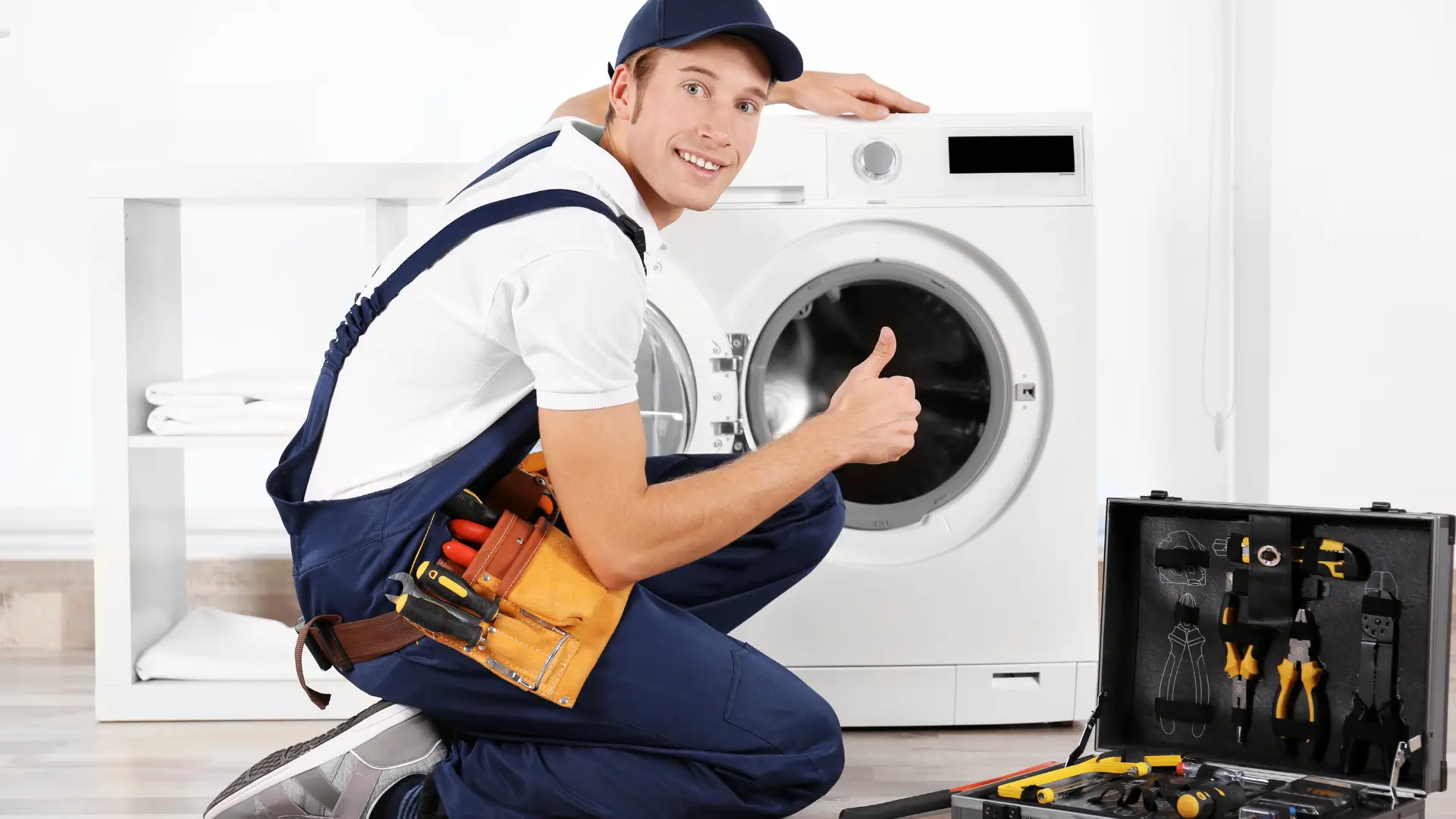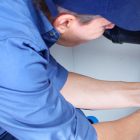Contents
A washing machine that won’t drain can be one of the most frustrating issues to deal with. You’re left with soaked clothes, a machine full of water, and a potential mess on your hands. In this blog, we’ll explore the most common reasons why your washing machine won’t drain and what you can do to fix it. By the end of this post, you’ll have a clear understanding of the problem and feel more confident in either tackling it yourself or knowing when to call a professional. So, let’s dive into the details.
1. Clogged Drain Hose
One of the most common reasons your washing machine won’t drain is a clogged drain hose. The drain hose is responsible for carrying the used water from the machine to your home’s plumbing system. Over time, it can get clogged with lint, dirt, or even small clothing items like socks. When this happens, water can’t pass through the hose properly, leading to drainage issues.
How to Check and Fix a Clogged Drain Hose
- Turn Off and Unplug the Machine: Safety first! Always turn off and unplug your washing machine before attempting any repairs.
- Locate the Drain Hose: The drain hose is usually located at the back of the washing machine. It’s typically a flexible tube that leads from the machine to a nearby drain or pipe.
- Check for Kinks: Sometimes, the hose might simply be kinked or bent, restricting water flow. Straighten out any kinks you find.
- Remove the Hose and Inspect: If there are no visible kinks, remove the hose from the washing machine. You may need pliers to loosen the clamp. Check inside the hose for any obstructions.
- Clean the Hose: If you find any blockages, remove them using a long brush or a piece of wire. Rinse the hose thoroughly before reattaching it.
- Reattach and Test: After cleaning the hose, reattach it securely to the washing machine and run a test cycle to see if the issue is resolved.
If you’ve gone through these steps and your washing machine won’t drain still, the problem might be elsewhere. But don’t worry, we have more potential fixes coming up.
2. Faulty Drain Pump
Another possible reason your washing machine won’t drain is a faulty drain pump. The drain pump is the component that physically moves water from the washing machine into the drain hose. If it’s malfunctioning, water won’t be able to exit the machine properly.
Signs of a Faulty Drain Pump
- Loud Noises: If you hear unusual noises, such as grinding or whining, during the drain cycle, the drain pump might be the culprit.
- Water Stays in the Drum: When the washing machine completes its cycle, but the drum is still full of water, it’s a strong indicator that the drain pump isn’t doing its job.
- Leaks: A damaged pump can also cause leaks, which you might notice pooling around the bottom of your washing machine.
How to Fix or Replace a Faulty Drain Pump
- Turn Off the Power: As always, make sure the washing machine is unplugged before you start any repairs.
- Access the Pump: The drain pump is usually located at the bottom front of the washing machine. You might need to remove a panel to access it.
- Inspect for Obstructions: Sometimes, small objects like coins or buttons can get caught in the pump. Check for any visible blockages and remove them.
- Test the Pump: If there are no visible obstructions, the pump itself might be broken. You can test it with a multimeter to see if it’s receiving power. If the pump isn’t working, it will need to be replaced.
- Replace the Pump: If you’ve determined that the pump is faulty, replace it with a new one. Make sure to get the correct model for your washing machine.
- Reassemble and Test: Once the new pump is installed, reassemble the washing machine and run a test cycle to ensure everything is working correctly.
Replacing a drain pump can be a bit tricky, and if you’re not comfortable doing it yourself, it might be worth calling in a professional. Speaking of which, if you’re in need of expert help, don’t hesitate to contact us at +971545356777.
3. Blocked or Clogged Filter
The filter in your washing machine plays a crucial role in catching debris before it can cause any damage. However, if the filter gets clogged, it can prevent your washing machine from draining properly. A blocked filter is one of the simpler issues to fix when your washing machine won’t drain.
How to Check and Clean the Washing Machine Filter
- Locate the Filter: The filter is usually located behind a small panel at the front of the washing machine, near the bottom. Some machines may have it at the back.
- Place a Towel or Tray: Before you open the filter compartment, place a towel or shallow tray underneath to catch any water that may spill out.
- Open the Filter Compartment: Carefully open the compartment and slowly unscrew the filter cap. Water will likely start to drain out, so be prepared.
- Remove and Clean the Filter: Once the water has drained, remove the filter completely. Check it for any debris, lint, or foreign objects, and clean it thoroughly under running water.
- Inspect the Filter Housing: While the filter is out, check the housing for any additional debris or blockages and clean as necessary.
- Reinstall the Filter: After cleaning, screw the filter back into place securely and close the panel.
- Test the Machine: Run a short cycle to ensure that the washing machine drains properly.
Cleaning the filter is a maintenance task that should be done regularly to prevent drainage issues. If your washing machine won’t drain even after cleaning the filter, there could be another underlying issue.
4. Belt Issues
The belt in your washing machine is responsible for turning the drum and, in some models, powering the drain pump. If the belt is worn, broken, or has slipped off its pulleys, your washing machine won’t drain as it should.
Signs of a Belt Problem
- Drum Not Spinning: If the drum isn’t spinning at all, or only spinning weakly, the belt might be loose or broken.
- Unusual Noises: A slipping belt might cause squeaking or squealing sounds during the spin cycle.
- Water Not Draining: Without the belt functioning properly, the machine may not be able to drain water.
How to Check and Fix Belt Issues
- Unplug the Machine: Always start by disconnecting the washing machine from the power supply.
- Access the Belt: The belt is usually located at the back of the washing machine. You may need to remove the back panel to see it.
- Inspect the Belt: Check if the belt is loose, worn, or broken. If it has slipped off the pulleys, it might just need to be repositioned. If it’s damaged, you’ll need to replace it.
- Reposition or Replace the Belt: If the belt has slipped, carefully reposition it on the pulleys. If it’s worn or broken, remove it and install a new one. Make sure the new belt is tensioned correctly.
- Test the Machine: After fixing the belt, reassemble the washing machine and run a test cycle to see if the problem is resolved.
Working with belts can be a bit challenging if you’re not used to mechanical repairs. If your washing machine won’t drain and you suspect a belt issue, and you’re not sure how to proceed, it might be a good idea to seek professional assistance.
5. Malfunctioning Lid Switch
The lid switch is a safety feature in many top-loading washing machine won’t drain. It prevents the washing machine won’t drain from spinning or draining if the lid is open. However, if the lid switch is malfunctioning, it can trick the machine into thinking the lid is open, which will stop the draining process altogether.
Symptoms of a Bad Lid Switch
- Washing Machine Won’t Drain or Spin: If the washing machine won’t drain stops mid-cycle and won’t drain or spin, the lid switch could be faulty.
- No Click Sound: Normally, you’ll hear a click when you close the lid. If there’s no sound, the switch might be broken.
How to Test and Replace a Lid Switch
- Unplug the Machine: Ensure the washing machine is disconnected from the power supply.
- Locate the Lid Switch: The lid switch is usually located near the lid hinge inside the machine’s top panel.
- Test the Switch: Use a multimeter to test the lid switch for continuity. If it doesn’t have continuity, it’s likely broken.
- Replace the Switch: If the lid switch is faulty, you’ll need to replace it. Unscrew the old switch, disconnect the wires, and install a new one in its place.
- Reassemble and Test: After replacing the switch, reassemble the machine and run a test cycle to ensure it’s working properly.
Lid switches are generally inexpensive and fairly easy to replace. If your washing machine won’t drain and you suspect the lid switch, this could be a straightforward fix.
6. Plumbing Issues
Sometimes, the problem isn’t with the washing machine won’t drain itself but with your home’s plumbing. If your washing machine won’t drain, it could be due to a blocked drainpipe or a problem with the plumbing system that prevents water from flowing out of the machine.
How to Identify Plumbing Problems
- Slow Drainage: If water drains very slowly from the washing machine, the issue might be a partial blockage in the plumbing.
- Backflow: If water from the washing machine backs up into sinks or other drains, this indicates a clogged drainpipe.
- Consistent Drainage Issues: If other appliances or fixtures are also having drainage problems, it’s likely a plumbing issue rather than a washing machine problem.
How to Fix Plumbing Problems
- Check for Clogs: If you suspect a plumbing issue, start by checking the drain where the washing machine won’t drain hose connects. Use a drain snake or plunger to clear any blockages.
- Call a Plumber: If the problem is more complex, or if you’re unable to clear the blockage yourself, it’s best to call a professional plumber to inspect and fix the issue.
- Test the Machine: Once the plumbing issue is resolved, run a cycle to see if the washing machine now drains properly.
Plumbing issues can be tricky, and attempting to fix them yourself might make things worse. If your washing machine won’t drain and you suspect a plumbing problem, don’t hesitate to reach out to a plumber for assistance.
If your washing machine won’t drain, it’s important to diagnose the problem accurately and fix it before it causes further damage. By understanding these common reasons, you’ll be better equipped to handle the situation. Whether it’s a clogged drain hose, a faulty pump, or a plumbing issue, taking action sooner rather than later can save you time, money, and frustration.
If you need professional help with your washing machine or any other home appliance, give us a call at +971545356777. Our experienced technicians are ready to help you get your washing machine won’t drain back in working order!



